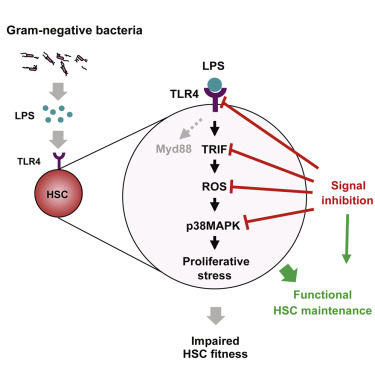当前位置:
X-MOL 学术
›
Cell Stem Cell
›
论文详情
Our official English website, www.x-mol.net, welcomes your
feedback! (Note: you will need to create a separate account there.)
Pathogen-Induced TLR4-TRIF Innate Immune Signaling in Hematopoietic Stem Cells Promotes Proliferation but Reduces Competitive Fitness.
Cell Stem Cell ( IF 19.8 ) Pub Date : 2017-08-03 , DOI: 10.1016/j.stem.2017.06.013 Hitoshi Takizawa 1 , Kristin Fritsch 2 , Larisa V Kovtonyuk 2 , Yasuyuki Saito 2 , Chakradhar Yakkala 2 , Kurt Jacobs 3 , Akshay K Ahuja 3 , Massimo Lopes 3 , Annika Hausmann 4 , Wolf-Dietrich Hardt 4 , Álvaro Gomariz 2 , César Nombela-Arrieta 2 , Markus G Manz 2
Cell Stem Cell ( IF 19.8 ) Pub Date : 2017-08-03 , DOI: 10.1016/j.stem.2017.06.013 Hitoshi Takizawa 1 , Kristin Fritsch 2 , Larisa V Kovtonyuk 2 , Yasuyuki Saito 2 , Chakradhar Yakkala 2 , Kurt Jacobs 3 , Akshay K Ahuja 3 , Massimo Lopes 3 , Annika Hausmann 4 , Wolf-Dietrich Hardt 4 , Álvaro Gomariz 2 , César Nombela-Arrieta 2 , Markus G Manz 2
Affiliation

|
Bacterial infection leads to consumption of short-lived innate immune effector cells, which then need to be replenished from hematopoietic stem and progenitor cells (HSPCs). HSPCs express pattern recognition receptors, such as Toll-like receptors (TLRs), and ligation of these receptors induces HSPC mobilization, cytokine production, and myeloid differentiation. The underlying mechanisms involved in pathogen signal transduction in HSCs and the resulting biological consequences remain poorly defined. Here, we show that in vivo lipopolysaccharide (LPS) application induces proliferation of dormant HSCs directly via TLR4 and that sustained LPS exposure impairs HSC self-renewal and competitive repopulation activity. This process is mediated via TLR4-TRIF-ROS-p38, but not MyD88 signaling, and can be inhibited pharmacologically without preventing emergency granulopoiesis. Live Salmonella Typhimurium infection similarly induces proliferative stress in HSCs, in part via TLR4-TRIF signals. Thus, while direct TLR4 activation in HSCs might be beneficial for controlling systemic infection, prolonged TLR4 signaling has detrimental effects and may contribute to inflammation-associated HSPC dysfunction.
中文翻译:

造血干细胞中病原体诱导的TLR4-TRIF天然免疫信号可促进增殖,但会降低竞争性。
细菌感染导致消耗了短命的先天免疫效应细胞,然后需要从造血干细胞和祖细胞(HSPC)中进行补充。HSPC表达模式识别受体,例如Toll样受体(TLR),并且这些受体的连接会诱导HSPC动员,细胞因子生成和骨髓分化。在HSC中病原体信号转导中涉及的潜在机制以及由此产生的生物学后果仍然不清楚。在这里,我们显示体内脂多糖(LPS)应用直接通过TLR4诱导休眠的HSC增殖,持续的LPS暴露会损害HSC的自我更新和竞争性的种群重建活性。此过程是通过TLR4-TRIF-ROS-p38介导的,但不是通过MyD88信号传导介导的,并且可以在药理上得到抑制,而不会阻止紧急的粒细胞生成。鼠伤寒沙门氏菌感染同样部分地通过TLR4-TRIF信号在HSC中诱导增殖应激。因此,虽然HSC中直接TLR4激活可能有益于控制全身感染,但延长的TLR4信号转导具有有害作用,并可能导致与炎症相关的HSPC功能障碍。
更新日期:2017-07-21
中文翻译:

造血干细胞中病原体诱导的TLR4-TRIF天然免疫信号可促进增殖,但会降低竞争性。
细菌感染导致消耗了短命的先天免疫效应细胞,然后需要从造血干细胞和祖细胞(HSPC)中进行补充。HSPC表达模式识别受体,例如Toll样受体(TLR),并且这些受体的连接会诱导HSPC动员,细胞因子生成和骨髓分化。在HSC中病原体信号转导中涉及的潜在机制以及由此产生的生物学后果仍然不清楚。在这里,我们显示体内脂多糖(LPS)应用直接通过TLR4诱导休眠的HSC增殖,持续的LPS暴露会损害HSC的自我更新和竞争性的种群重建活性。此过程是通过TLR4-TRIF-ROS-p38介导的,但不是通过MyD88信号传导介导的,并且可以在药理上得到抑制,而不会阻止紧急的粒细胞生成。鼠伤寒沙门氏菌感染同样部分地通过TLR4-TRIF信号在HSC中诱导增殖应激。因此,虽然HSC中直接TLR4激活可能有益于控制全身感染,但延长的TLR4信号转导具有有害作用,并可能导致与炎症相关的HSPC功能障碍。









































 京公网安备 11010802027423号
京公网安备 11010802027423号